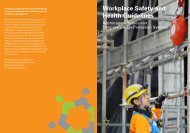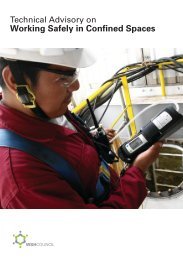Code of Practice - Workplace Safety and Health Council
Code of Practice - Workplace Safety and Health Council
Code of Practice - Workplace Safety and Health Council
Create successful ePaper yourself
Turn your PDF publications into a flip-book with our unique Google optimized e-Paper software.
installation <strong>of</strong> the equipment shall be addressed in the RA <strong>and</strong> in the Lifting Plan. Lifting equipment<br />
must be positioned or installed in order to:<br />
• eliminate or reduce the risks to public or buildings in the immediate vicinity <strong>of</strong> the lifting<br />
operation;<br />
• avoid having the load being manoeuvred over people;<br />
• avoid striking, trapping or crushing persons;<br />
• avoid striking any other structures such as buildings;<br />
• ensure that entrance <strong>and</strong> exit paths <strong>of</strong> existing passageways are not compromised by risks<br />
arising from the lifting operations;<br />
• avoid collision with other lifting equipment being used simultaneously; <strong>and</strong><br />
• provide suitable gates/ barriers to prevent inappropriate/ unsafe access to any hoist area.<br />
The above list is not exhaustive. Any lifting equipment must be positioned or installed such that the<br />
risks <strong>of</strong> lifting equipment or load injuring people or assets are minimised.<br />
4.3.2 In general, whenever lifting equipment are disassembled <strong>and</strong> reassembled, they shall be<br />
subjected to a thorough re-inspection <strong>and</strong> load tested as per legal requirements by an Authorised<br />
Examiner. This is to ensure the integrity <strong>and</strong> stability <strong>of</strong> the equipment during the reassembly process.<br />
4.4 Identification <strong>of</strong> Lifting Equipment<br />
4.4.1 Every lifting equipment <strong>and</strong> its component parts shall be identified with a visible marking<br />
including the safe working load (SWL). The markings serve the following purposes.<br />
• Communicate clearly the maximum safe working load <strong>of</strong> the equipment.<br />
• Communicate clearly the maximum number <strong>of</strong> persons it can carry if it is used for lifting<br />
people.<br />
• Facilitate the identification <strong>of</strong> the equipment <strong>and</strong> its component including whether it is<br />
genuine <strong>and</strong> compatible with the equipment.<br />
4.4.2 Where practicable, the SWL should be marked on the equipment conspicuously. But where<br />
this is not possible (e.g., a small lifting gear) a coding system can be used to provide the user with the<br />
required information. Examples <strong>of</strong> such systems include colour coding or attaching some form <strong>of</strong> label.<br />
4.4.3 Where a number <strong>of</strong> lifting accessories are assembled to form single lifting equipment which is<br />
not dismantled after use, the assembly should be marked to indicate its safety characteristics to users.<br />
4.4.4 Where there are other characteristics which may cause a lifting accessory to become<br />
unsuitable for use in a particular application, then this information should be marked or otherwise be<br />
available to the user.<br />
Page 17 <strong>of</strong> 38

















